
Imagine ordering your favourite momo online, and the app suddenly crashes at the payment screen. 🥟🚫 Frustrating, right?
This is where reliability in software systems steps in to save the day.
In this blog post, we’ll explore reliability in-depth, sprinkled with fun analogies and insights to keep things interesting.
What Is Reliability?
Reliability in system design refers to the ability of a system to consistently perform its intended function without failure over a specified period. Think of it as the system’s way of saying, “Don’t worry, I’ve got this!” 😉
To make this relatable: reliability is like your morning coffee machine. You expect it to brew your coffee every day without fail, even if you’re half-asleep pressing the wrong button. ☕😴
Reliable systems are expected to:
- Perform as intended (no surprise errors, please!).
- Handle unexpected inputs gracefully (oops, I didn’t mean to click that!).
- Work well under expected load and data volume.
- Prevent unauthorized access or abuse (no sneaky hackers allowed 🕵️♂️).
In essence, reliability means working correctly even when things go wrong.
What Could Go Wrong? (A Lot, Actually 😅)
In the world of software, things that go wrong are called faults. Systems that anticipate faults and can cope with them are known as fault-tolerant. However, it’s essential to clarify that faults don’t necessarily mean failures. Let’s break this down:
- Fault: One component deviates from its specification (e.g., a server running out of memory).
- Failure: The system as a whole stops working for the user (e.g., “Error 500: Internal Server Error”).
A good analogy? A flat tyre on your car is a fault. If you have a spare tyre and know how to replace it, your journey continues—no failure! 🚗🕺
Types of Faults (Brace Yourself 😲)
1. Hardware Faults
These are like the sneaky gremlins of the tech world:
- Hard disks crash 🪄.
- RAM becomes faulty.
- Someone unplugs the wrong cable (oops).
The Fix? Redundancy! Think of RAID-configured disks, dual power supplies, and backup generators. It’s all about having Plan B, C, and D.
Fun Fact: In a data center with 10,000 disks, you can expect one disk to fail every day. That’s why redundancy isn’t a luxury; it’s a necessity.
2. Software Errors
Ah, the bane of developers’ lives:
- A bug that causes the system to crash under specific inputs (
hello, a faulty update to CrowdStrike’s Falcon Sensor security software caused a massive IT outage 🚀). - Processes hogging all resources (CPU, memory, disk space, you name it).
- Dependency issues, where one failing service brings others down🌐.
The Fix?
Testing, monitoring, and error handling. Proactively induce faults (shoutout to Netflix Chaos Monkey 🐒) to test fault-tolerance mechanisms. Remember, a system’s strength is tested in its weakest moments.
3. Human Errors
We’re only human, after all. Studies show that operator errors are a leading cause of outages. Examples include misconfigurations or accidental deletions. 🙈
The Fix?
- Design intuitive systems that guide users toward the “right” actions.
- Provide sandboxes for safe experimentation.
- Implement robust monitoring and rollback mechanisms (“Oops, let’s undo that!”).
Pro Tip: Always have clear telemetry—it’s your system’s way of crying for help.
Measuring Reliability (Quantifying the Magic ✨)
To design a reliable system, you need metrics. Enter MTBF and MTTR:
- Mean Time Between Failures (MTBF): Average time a system runs without failing.
- Mean Time to Repair (MTTR): Average time to fix a failure.
Together, these metrics help gauge overall reliability. High MTBF and low MTTR? Chef’s kiss! 😍
Reliability vs. Availability: Are They the Same?
Not quite. A reliable system works without failure. An available system works when you need it.
For example, a solar-powered calculator is reliable but not always available (no sun, no fun). On the other hand, an unreliable app that crashes intermittently but is accessible 24/7 is available but frustrating.
The goal? Balance reliability and availability to meet Service-Level Objectives (SLOs).
Reliability in Distributed Systems (The Ultimate Challenge 🌌)
Distributed systems bring unique challenges:
- Hardware failures scale with the number of machines.
- Network partitions occur.
- Data consistency becomes a nightmare.
The Fix? Techniques like:
- Replication: Data copies in multiple locations.
- Load Balancing: Sharing the workload across nodes.
- Fault Detection: Quickly identifying and isolating faulty components.
Example: If one of your database servers is wiped out by an earthquake, your data remains safe thanks to replication. Now that’s reliability! 🌋🔧
Why Should You Care About Reliability?
Reliability isn’t just for rocket launches or nuclear plants. Even everyday applications demand it:
- E-commerce: Downtime equals lost revenue and reputation damage 🚫💸.
- Photo Storage Apps: Imagine losing years of precious memories due to a corrupt database. Not cool! 😢
While cutting corners on reliability might save costs initially, it’s a gamble that often backfires. A reliable system not only builds trust but also saves money in the long run.
Closing Thoughts: Reliability with a Human Touch
Designing reliable systems is like being a good friend: dependable, consistent, and always there when needed. It’s not about eliminating all faults (because, let’s face it, nobody’s perfect), but about gracefully handling them when they arise.
As developers, we owe it to our users to build systems they can rely on. After all, no one wants to deal with “Error 404” when they’re just trying to enjoy their pizza. 🍕
Let’s design systems that make life a little less stressful and a lot more predictable—because reliability is not just a feature; it’s a promise. ❤️